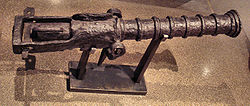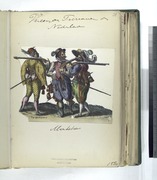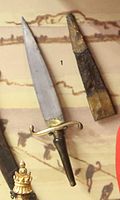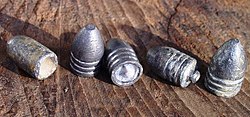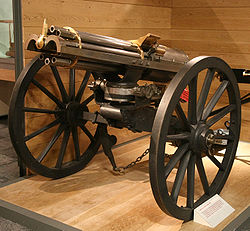| Year | Date | Region | Event |
|---|
| 1307 | | West | The Armenian monk Hetoum writes about a powerful weapon having been invented in China. |
| 1325 | | China | Bronze "thousand-ball thunder-cannons" on four wheeled carriages appear in the Yuan dynasty. |
| 1326 | | West | In Europe the depiction of a cannon appears. [67] |
| 1330 | | West | In Andalusia cannons are mentioned in textual sources. [68] |
| West | Europe's oldest extant firearm, the Loshult gun, is dated to this year. [69] |
| 1331 | | Iberia | The Nasrid army besieging Elche makes use of "iron pellets shot with fire." [70] |
| 1333 | | West | Earliest extant cannon arrow projectile is dated to this year. Now kept in the Eltz Castle. |
| 1338 | | West | An organ gun and three pounds of gunpowder are recorded to have been in the possession of a raiding party that sacked Southampton. |
| 1339 | | West | The word "cannon", derived from the Greek kanun and Latin canna, meaning "tube," is used for the first time in Europe. |
| West | The word "gun" is used to describe a firearm in English for the first time. |
| 1340 | | China | A "watermelon bomb" containing miniature rockets known as "ground rats" is employed by Liu Bowen against rebels and pirates in Zhejiang. |
| 1344 | | West | Wooden cannons appear in Europe. |
| 1346 | 26 August | West | Battle of Crécy : Organ guns are used. |
| West | The term "bombard" is used to refer to guns of any kind. [76] |
| 1350 | | China | Cast iron technology becomes reliable enough to make one-piece iron cannons in China. |
| China | Flint and wheel mechanisms are employed in igniting land mines and naval mines in China. |
| China | In China organ guns appear. |
| China | Two wheeled gun carriages appear in China. |
| India | India acquires rockets. |
| 1352 | | Southeast Asia | Cannons are mentioned to have been used by the Ayutthaya Kingdom in their invasion of the Khmer Empire |
| 1358 | | China | Defending garrisons fire cannons en masse at the siege of Shaoxing and defeat a Ming army. [83] |
| 1360 | | Middle East | In the middle east metal-barrel guns start appearing in textual sources. [68] |
| Southeast Asia | Gunpowder barrels aboard a Khmer ship explode. |
| 1363 | 30 August – 4 October | China | Battle of Lake Poyang : Cannons are used in ship combat and a new weapon called the "No Alternative" also appears. It consists of a reed mat bundled together with gunpowder and iron pellets hung on a pole from the foremast of a ship. When an enemy ship is within range, the fuse is lit, and the bundle falls onto the enemy ship spitting iron pellets and burning their men and sails. [84] |
| 1364 | | West | Breech loading cannons start appearing in Europe. |
| 1366 | | China | Two thousand four hundred large and small cannons are deployed by the Ming army at the siege of Suzhou. [83] |
| India | The Vijayanagara Empire acquires firearms. |
| 1368 | | China | Crouching-tiger cannons are employed by the Ming army. |
| 1370 | | China | Gunpowder is corned to strengthen the explosive power of land mines in the Ming dynasty. [88] |
| China | Cannon projectiles transition from stone to iron ammunition in the Ming dynasty. [89] |
| 1372 | | China | Cannons made specifically for naval usage appear in the Ming dynasty. |
| 1373 | | West | The term "hand gun", also known as handgonne, gunnies, vasam scolpi, pot, capita, and testes, appears in European texts for the first time. |
| 1374 | | Sinosphere | Goryeo starts producing gunpowder. [92] |
| West | Cannons breach a city wall for the first time in Europe. |
| 1375 | | West | "Basilisk" cannons appear. |
| West | A 900 kg large-calibre gun is produced in Europe. |
| Worldwide | Flash pans are added to hand cannons. |
| West | European gunsmiths begin testing barrels for structural integrity, improving quality. |
| 1377 | | Sinosphere | Goryeo starts producing cannons and rockets. [97] |
| 1380 | | China | "Wasp nest" rocket launchers are manufactured for the Ming army. |
| 24 June | West | Battle of Chioggia : In Europe rockets are used in battle. |
| West | Europeans develop the means to produce saltpeter for themselves. |
| 1382 | | West | European sailing ships are equipped with cannons. |
| 3 May | West | Battle of Beverhoutsveld : The first military conflict in Europe where cannons play a decisive role. |
| 1388 | | China | Ming–Mong Mao War : Volley fire is implemented with cannons by the Ming artillery corps in the anti-insurrection war waged against the Mong Mao. [102] |
| West | Saltpeter plantations start appearing in Europe. |
| 1390 | | Southeast Asia | Đại Việt soldiers kill the king of Champa, Che Bong Nga, using hand cannons. |
| 1396 | | West | In Europe mounted knights start employing fire lances. |
| 1398 | 17 December | India | Delhi Sultanate uses bombs against Tamerlane. |
| 1399 | | West | Germany's oldest extant firearm is dated to this year. [107] |
|




























